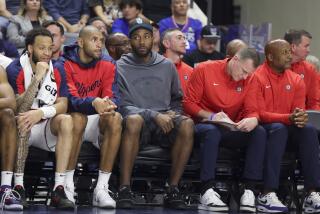Andrew Bynum’s injuries probably just bad luck
- Share via
The latest injury to Andrew Bynum probably has more to do with bad karma than inherently bad knees, medical experts said Tuesday.
The Lakers’ 21-year-old star suffered his second major knee injury in two seasons Saturday when Kobe Bryant collided with him in the first quarter of the game against the Memphis Grizzlies. Bynum’s two injuries are unrelated, however, and don’t foreshadow a career punctuated by knee problems, sports medicine doctors say.
“They are two completely different injuries,” said Dr. Nicholas DiNubile, a spokesman for the American Academy of Orthopaedic Surgeons and a former team physician for the Philadelphia 76ers. “It’s not like, ‘oh my God, this guy has really vulnerable knees.’ This is, by no means, career-ending. This will heal.”
Bynum was diagnosed Monday with a torn medial collateral ligament in his right knee and will miss eight to 12 weeks of the season. In January 2008, he briefly dislocated his left kneecap when he came down on teammate Lamar Odom’s foot. He missed the rest of the season and had surgery to remove cartilage debris from his left knee last May.
Bynum will not walk away from back-to-back knee injuries completely unscathed, however. His kneecap injury suggests that he is a bit loose-jointed. And both knees probably will be sensitive to contact injuries in the future, DiNubile said.
The medial collateral ligament, or MCL, is one of four ligaments that stabilize the knee during movement. It runs along the inside of the joint and keeps it from bending in. The ligament is typically injured if the knee jerks inward with the foot bent outward. Collisions are most often the cause.
“This injury is like a clipping injury in football,” DiNubile said. “You’re hit on the outside and the knee buckles inward. That can happen to anyone. But it’s more likely to happen to someone who is loose-jointed.”
MCL injuries are diagnosed in severity as grade one, two or three. The Lakers declined to identify the grade associated with Bynum’s injury. However, the length of his expected rehabilitation suggests a grade-three injury, the most severe type, which is a complete tear of the ligament, DiNubile said.
Bynum and the Lakers, who signed him to a four-year, $57.4-million contract extension last fall, are probably fortunate that his latest mishap wasn’t worse. MCL injuries are often accompanied by damage to the more susceptible anterior cruciate ligament. Medial ligaments tend to heal with rest, whereas ACL injuries usually require surgery.
“People hear a lot about the ACL, but that’s because an injured ACL almost always requires surgery to fix. The MCL heals on its own,” said Dr. Matthew Matava, an associate professor of orthopedic surgery at Washington University School of Medicine in St. Louis and the chief team doctor for the St. Louis Rams.
“If you were to pick an injury to a knee, [the MCL injury] is probably one that is the least severe and has probably the best prognosis for the future,” added Dr. Andrew Bulczynski, a sports medicine specialist at Marina del Rey Hospital.
MCL injuries occur frequently in sports but aren’t that common among NBA players, said Dr. Walter R. Lowe, chief of sports medicine at Baylor College of Medicine and the team physician for the NFL’s Houston Texans. Washington Wizards center Etan Thomas suffered the same injury as Bynum in January and is also expected to be out eight to 12 weeks.
“This is one of those contact-related, freak things that really doesn’t happen too often on the basketball court,” Lowe said. “I was the team physician for the Rockets, and I saw one MCL tear in 12 years.”
Bynum’s previous injury, the dislocated kneecap, was more serious and may reflect a tendency toward that type of injury, DiNubile said. “Some people are more prone to have a kneecap that slips out. It’s just how your body is built. He was probably a little bit predestined to that injury. This one is different. Anyone can have this.”
It takes basketball players longer to return to action from an MCL tear than a football player because of the cutting movements and jumping involved in basketball, Lowe said. A mild medial ligament sprain would sideline most athletes for only a week or two. The eight-to-12-week time frame given for Bynum’s recovery suggests the Lakers’ physicians want him fully recovered before entering a game.
“Knowing what happened last year, they probably have a time frame where they don’t want him to get re-injured,” said Dr. Tim Gibson, an orthopedic surgeon at Orange Coast Memorial Medical Center in Fountain Valley. “So I would think that they are trying to be very conservative.”
Bynum’s right knee could be a bit more vulnerable to injuries in the future, however, especially in the first few weeks after he returns, Matava said. “Those knees are often a bit looser,” he said. “The ligament heals in a lengthened position. So it’s more lax.”
However, Bynum’s biggest challenge may be mental, Lowe said. It will be important for him to shake any doubts that his knees will hold up to the rigors of the game.
“You would expect that he would be pretty bummed,” Lowe said. “It’s like deja vu from last year. That is frustrating, but it’s part of the world of guys who play sports for a living. Most guys deal with those things mentally very well.”
Bynum is scheduled to begin rehabilitation after a week or two of rest. Doctors prefer to keep athletes out of a cast in order to speed rehabilitation, DiNubile said. If a joint is immobilized, the scar tissue that forms around the injury is of poor quality and can cause problems in the future. However, when athletes are able to condition and strengthen the joint as it heals, the scar tissue tends to form in smooth bands that mimic the natural movement of the joint.
With a bit of luck, Bynum should be moving like himself on the court again soon.
--
broderick.turner@latimes.com
--
Tonight’s game
LAKERS AT TORONTO
4 PST, Channel 9
More to Read
All things Lakers, all the time.
Get all the Lakers news you need in Dan Woike's weekly newsletter.
You may occasionally receive promotional content from the Los Angeles Times.









